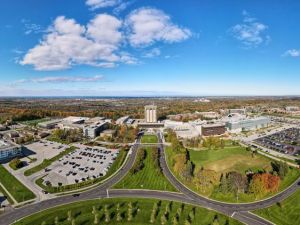 Brock University Biology Professor Miriam Richards examines bees collected at the Glenridge Quarry Naturalization site in St. Catharines.
Brock University Biology Professor Miriam Richards examines bees collected at the Glenridge Quarry Naturalization site in St. Catharines.Restore it and they will come. But they won’t stay for long if conditions are not right.
This is what Brock University bee expert Miriam Richards and her research team found in their recently published study of bee populations living in a landfill-turned-nature park in St. Catharines.
In 2003, when a former landfill located near the University reopened to the public as the Glenridge Quarry Naturalization site, the professor of biology and her team set up 30 bee traps for their study.
Between 2003 and 2013, the research team collected and recorded the number of bees and number of species they got from the traps, and compared that to traps they set in three sites at Brock that had not been restored.
The team found that the numbers of individual bees and bee species in the Glenridge Quarry Naturalization site went up, at first.
“Our results suggest that ‘If you restore it, they will come’: restored foraging and nesting sites were re-occupied by bees as soon as they became available, then bee numbers continued to grow for three to four years,” says the study, “Rapid initial recovery and long-term persistence of a bee community in a former landfill” published recently in the journal Insect Conservation and Diversity.
But after initial growth, bee populations and species at the restored site declined from 2007 onward. Meanwhile, bee populations at the unrestored land sites continued to decline from 2003 onward.
Richards’ study, funded by the Natural Sciences and Engineering Research Council of Canada, puts the spotlight on a trend that has scientists and environmentalists worried: the worldwide drop in bee populations.
Richards says the biggest reason for the population decline is the destruction of bee habitat.
“Most bees live in the ground. The problem is that humans have a tendency to cover the ground with concrete, buildings and monoculture crops that require plows, so we’ve removed huge amounts of places for bees to live,” she says.
Another threat to bees’ survival are human-made chemicals, specifically a group of agricultural pesticides called neonicotinoids, which were the focus of a series of studies recently linking their use to the declining bee population.
“Neonicotinoids interfere with bees’ brain chemistry and neurons, and with their learning and survival,” says Richards.
Fewer plants that bees use as their pollen and nectar sources and the impacts of climate change also threaten bees’ survival.
“A lot of bees, like many other animal and plant populations, are showing the effects of being hit with a huge number of environmental stressors. Bees end up going into precipitous declines,” Richards says. “This is very, very frightening. I try not to think about it. It gives me a bad feeling in the pit of my stomach.”
Bees are central to the world’s food supply and the stability of the ecosystem. Classified as pollinators, bees fertilize plants by transferring pollen and seeds from one flower to another. Without this transfer, many crops and other plants would die off.
Wild bees perform much of this pollination function. Richards’ research, headquartered in the Brock Bee Lab, focuses on the ecology and behaviour of wild bees, particularly carpenter bees and sweat bees.
Richards has advice for people who want to increase bee numbers: “Plant a lot of flowers, shrubs and flowering trees; don’t mulch everything in your garden because they can’t nest on the ground if there’s too much mulch; create nooks and crannies for nesting by leaving dead, hollowed-out stems. A little bit of wildness is beautiful.”
She advises against placing beehives in yards, saying that competition from a large number of honey bees in the small space of a yard will crowd out wild bees’ food sources, causing a decline in the wild bee population.
Honey bees, introduced to North America centuries ago, are considered “domesticated” because they produce a food product, says Richards.









